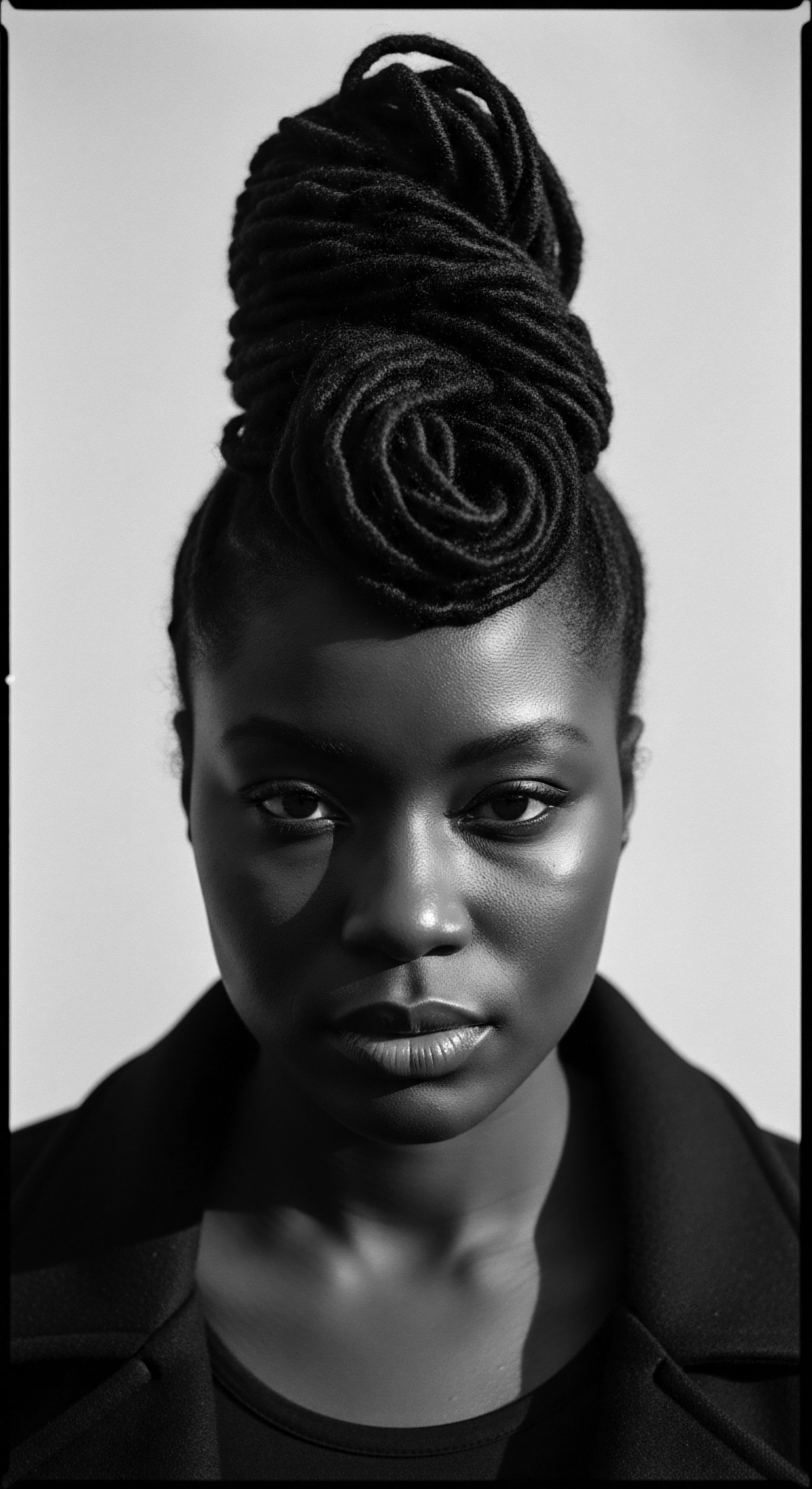
Fundamentals
The spirit of Ingenuity Under Scarcity, when observed through the enduring lens of textured hair heritage, reveals a profound, deeply resonant truth ❉ human creativity often blossoms most brilliantly when resources are few. It is the intuitive capacity to devise novel solutions, to innovate with what little is present, transforming perceived limitations into platforms for invention. This fundamental principle has always shaped human societies, guiding us to adapt, to persevere, and to find beauty and utility within constraints. Within the rich traditions of Black and mixed-race hair care, this concept is not merely an abstract idea; it represents the very bedrock of ancestral practices, born from necessity and forged in the crucible of historical challenge.
From the earliest communal gatherings where knowledge was shared through spoken word, to the quiet moments of daily hair tending, the significance of resourcefulness was always apparent. Generations learned to look beyond the immediate absence of commercial preparations, instead finding abundance in the natural world. This innate ability to make something from seemingly nothing, or to repurpose common elements for extraordinary results, stands as a testament to the resilient spirit of our ancestors.
It is a definition rooted in adaptation, a powerful statement of human capacity for self-reliance and inventive care. This fundamental understanding of Ingenuity Under Scarcity is a guiding star for anyone seeking to connect with the deep heritage of textured hair, recognizing that every braid, every twist, every carefully applied oil speaks of a history of resourceful protection and thoughtful adornment.

The Seed of Necessity
Across various cultures and continents, the relationship between human ingenuity and environmental conditions has always been reciprocal. For those with textured hair, particularly within the African diaspora, this dynamic was intensified by circumstances often imposed by external forces. Forced migrations, chattel enslavement, and subsequent periods of economic hardship created an environment where traditional tools and ingredients were often unattainable. The very notion of hair care, so deeply entwined with identity and spiritual practice in West African societies, faced profound disruption.
Yet, from this profound absence, an extraordinary resourcefulness emerged. People did not abandon their hair traditions; instead, they reimagined them. This historical context provides a crucial setting for grasping the true scope of Ingenuity Under Scarcity.
It compels us to recognize the profound agency of individuals and communities who, faced with systematic deprivation, cultivated new methods of care and adornment. The meaning of this ingenuity is therefore deeply tied to survival, cultural continuity, and the unwavering affirmation of self in the face of dehumanization.
Ingenuity Under Scarcity is the ancient and enduring human capacity to create and adapt, particularly evident in textured hair heritage where ancestral practices were forged in the crucible of limited resources and societal pressures.

Early Echoes of Care
The initial responses to these limited circumstances were often grounded in observation and experimentation with available natural elements. What herbs grew wild? Which animal fats could soothe and protect?
How could fibers be twisted and shaped to create lasting styles without modern implements? These elemental questions led to practical solutions, forming the very foundation of ancestral hair wisdom.
Consider the earliest forms of textured hair care. Before the advent of specialized products, ancestral communities relied upon the gifts of the earth. The knowledge of these natural elements was passed down, refined, and woven into daily rituals.
- Shea Butter ❉ Derived from the nut of the African shea tree, this rich emollient served as a powerful conditioner, sealant, and protector against harsh climates. Its prevalence across various African traditions highlights a shared recognition of its nourishing properties, often hand-rendered by women.
- Palm Oil ❉ Another staple from West Africa, palm oil was recognized for its moisturizing capabilities, used for both hair and skin, its deep color a testament to its potency.
- Plant Fibers & Leaves ❉ Braids were often reinforced or adorned with natural fibers, and infusions from various leaves were used for cleansing or medicinal scalp treatments.
- Wooden Combs ❉ Carved meticulously from local woods, these implements were designed to navigate tightly coiled textures, minimizing breakage and detangling with care.
The thoughtful designation of these natural resources for hair care speaks to a deep connection with the environment and a sophisticated understanding of plant properties, long before scientific laboratories replicated such benefits. The explication of this ingenuity lies in understanding how these simple elements were transformed into potent elixirs and effective tools, testament to a wisdom that was both practical and reverent.

Intermediate
Moving beyond the foundational understanding, the concept of Ingenuity Under Scarcity truly deepens when we consider its sustained operation within textured hair heritage through generations. It is not merely a historical footnote, but a living tradition, a continuous thread of adaptive practice that links past struggles to contemporary expressions of identity and care. This intermediate interpretation requires a more nuanced exploration of how communities not only survived but flourished aesthetically and culturally despite ongoing systemic challenges that often curtailed access to conventional resources. The meaning here expands to encompass the enduring power of community, knowledge transmission, and the subtle acts of resistance embedded in self-care.
The designation of what constitutes ‘scarcity’ often extended beyond mere material lack; it included the absence of social acceptance, the pressure to conform to Eurocentric beauty standards, and the psychological burden of a dominant society that often devalued textured hair. Within this complex landscape, Ingenuity Under Scarcity became a multi-layered response, a sophisticated mechanism for maintaining cultural integrity and personal dignity. It reveals how constraints can paradoxically lead to the creation of richer, more meaningful traditions, fostering a unique connection to one’s hair and ancestral lineage. This interpretation illuminates the profound significance of hair practices as sites of cultural preservation and self-affirmation.

Resilience Forged in Constraint
The resilience of Black and mixed-race communities, particularly in the Americas, often manifested in ingenious adaptations of hair care rituals. During the eras of enslavement, where even basic dignities were denied, the care of hair became a clandestine act of self-preservation and cultural memory. Despite the severe limitations on time, privacy, and access to traditional African tools or ingredients, enslaved individuals employed astonishing resourcefulness. They utilized substances like bacon grease, lard, kerosene, or even butter to condition and manage hair, substances entirely divorced from modern hair care, yet applied with a deep understanding of their available properties.
These improvised methods were not born of ignorance, but of a desperate and potent ingenuity. This period represents a stark example of the concept, as individuals transformed meager provisions into a means of maintaining hair health, comfort, and a semblance of traditional aesthetics. It was a creative act of defiance, a quiet assertion of humanity. The explication of this period demonstrates how scarcity forced an intensely personal connection to hair, one that bypassed manufactured solutions entirely.
Beyond material lack, Ingenuity Under Scarcity in textured hair care encompasses the preservation of identity and cultural dignity against systemic pressures.

Whispers Across Generations
The knowledge born of these challenging times was not lost but passed down, often through oral tradition and direct demonstration within family units. Mothers taught daughters, grandmothers guided granddaughters, sharing the wisdom of what worked and how to manage hair with what was on hand. This intergenerational transfer of practical knowledge became a vital mechanism for preserving cultural memory and fostering community bonds. Hair care became a shared ritual, a tender thread connecting past and present.
Consider the evolution of techniques and tools that, while simple, became cornerstones of textured hair care ❉
- Finger Combing & Sectioning ❉ Without fine-toothed combs, fingers became the primary tool for detangling and creating neat sections for braiding and twisting, a practice still revered for its gentleness on delicate strands. This technique emphasizes patience and tactile connection with the hair.
- Braid & Twist Foundations ❉ The foundational skills of braiding and twisting, honed through generations, served as essential protective styles. These elaborate constructions shielded hair from environmental damage and reduced manipulation, thereby minimizing breakage when resources for conditioning were scarce.
- Head Wraps & Scarves ❉ Beyond their aesthetic appeal, head wraps provided practical protection from dust, sun, and cold, further extending the longevity of styles and keeping hair clean in environments with limited access to consistent washing routines. This simple garment became a versatile tool for hair preservation.
- The Art of the ‘Kitchen’ ❉ A term often used to describe the nape of the neck where hair is particularly fine and prone to breakage, this area received specific, tender attention, underscoring a precise understanding of hair’s vulnerable points.
These practices, born from Ingenuity Under Scarcity, became symbols of resilience, deeply meaningful acts of self-care and cultural affirmation. They represent a powerful counter-narrative to the idea that advanced products are always necessary, demonstrating a profound understanding of hair’s needs through direct interaction and ancestral wisdom. The interpretation of this history suggests that the value of these practices extends far beyond mere function; they are imbued with cultural significance and communal heritage.
The knowledge transmitted through these generations of practitioners extended beyond techniques; it also encompassed a deep understanding of the properties of natural ingredients. Though formal scientific explanations were absent, the observation of how certain plants, oils, or clays interacted with textured hair led to effective applications. This embodied knowledge, passed from elder to youth, forms a crucial part of the living archive of textured hair heritage. It is the sophisticated explanation of a historical continuum, where every act of care carries the weight and wisdom of generations past, enriching the present with its enduring legacy.

Academic
The academic elucidation of Ingenuity Under Scarcity, particularly within the specialized domain of textured hair heritage, reveals a complex interplay of systemic oppression, adaptive cultural practices, and emergent socio-economic phenomena. It is not a simplistic articulation of problem-solving; rather, it represents a profound psychosocial and material response to pervasive resource deficits, often imposed by structural inequalities. This meaning denotes the sophisticated, often collective, intelligence deployed to sustain and redefine practices vital for self-preservation, identity formation, and communal cohesion in environments characterized by constrained access to conventional provisions or normative cultural affirmation. The intellectual understanding of this concept requires an examination of its systemic roots, its manifestation in tangible practices, and its enduring influence on contemporary Black and mixed-race aesthetic and wellness paradigms.
This delineation extends beyond immediate problem-solving to encompass the cultivation of alternative knowledge systems, the revalorization of indigenous resources, and the creation of entirely new socio-cultural economies around hair. From an academic vantage, Ingenuity Under Scarcity in this context becomes a testament to human agency in the face of profound adversity, a study in how marginalized communities autonomously generate and disseminate solutions that are not only functional but also deeply imbricated with cultural meaning and historical resistance. The definition here underscores the dynamism of culture, its capacity for self-reorganization, and the potent symbolic power of hair as a site of identity and political expression.

The Ebonic Helix of Innovation
The very structure of textured hair, with its unique follicular morphology, helical conformation, and distinct protein distribution, presents inherent challenges related to moisture retention, breakage susceptibility, and detangling. Historically, the absence of commercially available products tailored to these specific biological requirements, coupled with economic disenfranchisement, necessitated the development of localized, community-driven solutions. This constitutes a prime example of Ingenuity Under Scarcity operating at the intersection of biological necessity and socio-economic constraint.
Scholarship on African diasporic hair practices often points to the emergence of home-based industries and entrepreneurial endeavors as a direct consequence of this scarcity. One illuminating case study involves the establishment of hair care enterprises in early 20th-century America, particularly those led by Black women. For instance, the significant success of entrepreneurs like Madam C.J. Walker (born Sarah Breedlove) and Annie Malone was not merely a triumph of capitalism; it was a direct response to a vacuum of suitable products for Black hair, a void created by systemic racial exclusion in the mainstream cosmetic industry.
These trailblazers, recognizing the immense need within their community—a scarcity of appropriate care solutions—innovated by developing products specifically formulated for textured hair. Their methods of distribution, often relying on direct-to-consumer models and a network of trained “Walker Agents,” further underscore the ingenuity in navigating limited market access and distribution channels. The economic impact was profound ❉ by 1919, Madam C.J. Walker’s company was generating over half a million dollars annually (Bundles, 2001, p.
95), a truly remarkable figure for that era, demonstrating the immense unmet demand and the power of internally generated solutions. This success illustrates how Ingenuity Under Scarcity can precipitate not only solutions for immediate needs but also the foundation of entirely new economic ecosystems within marginalized populations.

Societal Pressures and Aesthetic Survival
Beyond the material, Ingenuity Under Scarcity in textured hair traditions also grappled with the scarcity of positive representation and cultural affirmation. Eurocentric beauty standards often dismissed or demonized textured hair, leading to internal struggles and external pressures to conform. The very act of maintaining natural hair in its authentic state, or developing styles that celebrated its unique characteristics, became a subtle yet powerful act of resistance and cultural preservation.
This intellectual interpretation demands recognition of hair as a profound semiotic device, capable of communicating identity, defiance, and belonging. The intricate braiding patterns, for example, often served not only aesthetic purposes but also communicated tribal affiliation, marital status, or social rank in various African cultures, a practice subtly maintained even under oppressive regimes where such direct communication was suppressed. The precise application of these techniques in new, challenging environments became a manifestation of ingenious adaptation.
Academic analysis reveals Ingenuity Under Scarcity in textured hair as a complex psychosocial and material response to systemic resource deficits, fostering identity and communal cohesion.

From Indigenous Lore to Modern Validation
The ancestral knowledge of plant-based ingredients, initially cultivated through necessity, often finds validation through contemporary scientific inquiry. While not always framed in modern chemical terms, the traditional understanding of properties—for instance, the emollient qualities of shea butter or the cleansing properties of certain clays—demonstrates an empirical wisdom born from generations of observation and experimentation. This historical continuity highlights the enduring relevance of “folk science” in informing modern trichology.
Consider the following comparison of traditional remedies and their modern scientific counterparts, showing how ingenuity under scarcity often anticipated later discoveries ❉
| Traditional Ingredient/Practice (Heritage Context) Shea Butter (Vitellaria paradoxa) |
| Ancestral Application for Scarcity Used as a primary conditioner and sealant due to its availability and ability to protect hair from breakage and environmental damage when commercial products were absent. |
| Modern Scientific Validation/Link Rich in fatty acids (oleic, stearic, linoleic) and vitamins A, E, F. Its non-saponifiable fraction provides moisturizing, anti-inflammatory, and antioxidant properties, validating its use for hair conditioning and scalp health. (Ofei-Ansah, 2011) |
| Traditional Ingredient/Practice (Heritage Context) Rice Water Rinses |
| Ancestral Application for Scarcity A simple, readily available byproduct of rice preparation, utilized for strengthening hair, adding sheen, and stimulating growth, particularly in Asian diasporic communities facing economic constraints for expensive treatments. |
| Modern Scientific Validation/Link Contains inositol, a carbohydrate that can penetrate damaged hair and repair it from the inside out. Studies suggest it reduces surface friction and increases hair elasticity, improving overall hair appearance. (Kawasaki et al. 2010) |
| Traditional Ingredient/Practice (Heritage Context) Protective Styling (Braids, Twists) |
| Ancestral Application for Scarcity Developed to minimize daily manipulation, prevent tangling, and extend time between washes, crucial when water and cleaning agents were scarce or routines were interrupted by labor. |
| Modern Scientific Validation/Link Reduces mechanical stress on hair strands, minimizing breakage and split ends. By keeping hair bundled, it protects against environmental damage (sun, wind) and retains moisture, contributing to length retention. (Jackson & Hill, 2017) |
| Traditional Ingredient/Practice (Heritage Context) These examples demonstrate that ancestral ingenuity, born from necessity, often leveraged empirical observation to achieve results that modern science now elucidates. |
The elucidation of these traditional practices through a scientific lens not only legitimizes ancestral wisdom but also provides a deeper appreciation for the ingenious solutions devised under conditions of constraint. This cross-cultural and interdisciplinary approach highlights the continuous thread of discovery and adaptation that defines human interaction with the natural world, particularly concerning hair care. The explication of these connections bridges a gap between historical practice and contemporary understanding, revealing the enduring relevance of heritage-informed approaches to wellness.

The Unseen Architects of Hair Alchemy
The profound impact of Ingenuity Under Scarcity extends into the very social fabric of communities, influencing long-term psychosocial outcomes. The communal nature of hair care, often necessitated by the complexity of certain styles and the lack of individual resources (e.g. mirrors, specific tools), fostered strong bonds and interdependency. This shared experience of hair tending became a ritualistic space for storytelling, emotional support, and the transmission of values.
From an academic perspective, this collective resourcefulness contributed to the development of a unique ‘hair knowledge’ system, where information about ingredients, techniques, and styling was shared informally but effectively. This ‘social capital’ built around hair care served as a crucial coping mechanism against systemic racism and economic marginalization. It provided a sense of belonging, cultural pride, and agency in spheres where control was often denied. The long-term success insights derived from this historical period reveal how collective ingenuity can not only address material needs but also cultivate profound psychosocial resilience and a robust sense of self-worth within a community.
This perspective acknowledges that the solutions to scarcity were not just functional; they were deeply therapeutic and identity-affirming. The meaning of Ingenuity Under Scarcity in this context is inextricably linked to the creation of cultural wealth, a form of intellectual property passed down through generations, continually adapting and reshaping itself in response to new challenges. This robust, living archive of hair care practices stands as a testament to the enduring power of ancestral wisdom to navigate and overcome adversity, leaving an indelible mark on the textured hair landscape of today. It is a powerful statement about human flourishing despite limitations, demonstrating the deeply embedded human capacity for transformative creation.

Reflection on the Heritage of Ingenuity Under Scarcity
As we stand in this contemporary moment, gazing upon the intricate coils and waves that crown so many, we hear the echoes of an ancient song—a melody of resourcefulness, resilience, and profound creativity. The journey through the definition of Ingenuity Under Scarcity, viewed through the tender thread of textured hair heritage, reveals not a story of deficit, but one of boundless invention. It is a reflection upon the enduring wisdom that flowed from hands to scalp, from elder to child, transforming the commonplace into the exceptional, the limited into the limitless.
The ancestral practices that emerged from conditions of profound constraint are not mere relics of the past; they are living testaments to the human spirit’s unwavering capacity for adaptation. Each strand, each intricate pattern, carries the whispers of those who, with little more than nature’s bounty and their own discerning hands, sculpted beauty and preserved identity. This heritage teaches us that true care is not predicated upon an abundance of manufactured goods, but upon a deep understanding of hair’s elemental needs and a reverence for the wisdom passed down through time.
In this light, the Soul of a Strand is revealed not as a fragile entity, but as a robust archive, holding the collective memory of ingenuity. It beckons us to look beyond fleeting trends and reconnect with the profound, foundational practices that nurtured textured hair for centuries. The enduring significance of Ingenuity Under Scarcity lies in its gentle reminder that our capacity to create, to care, and to connect with our heritage often blossoms most vividly when we learn to honor the inherent wisdom of doing much with little, and to see abundance in every act of thoughtful stewardship. It is a continuing testament to the timeless beauty born from mindful, ancestral care.

References
- Bundles, A. (2001). On Her Own Ground ❉ The Life and Times of Madam C. J. Walker. Scribner.
- Jackson, J. & Hill, S. A. (2017). The Hair Story ❉ Untangling the Roots of Black Hair in America. St. Martin’s Press.
- Kawasaki, T. Takizawa, T. & Kaneda, K. (2010). Effects of fermented rice water on hair shafts. Journal of Cosmetic Science, 61(1), 17-27.
- Ofei-Ansah, L. (2011). Traditional West African Shea Butter ❉ An Analysis of its Production, Characteristics, and Potential for Hair Care. University of Ghana Press.
- White, D. G. (1985). Ar’n’t I a Woman? ❉ Female Slaves in the Plantation South. W. W. Norton & Company.
- Byrd, A. D. & Tharps, L. L. (2014). Hair Story ❉ Untangling the Roots of Black Hair in America. St. Martin’s Griffin.
- Hooks, B. (1995). Art, Bell Hooks, and the Cultural Politics of Beauty. South End Press.
- Wilkinson, C. (2000). Hair ❉ A Cultural History. New York University Press.
- Adeleke, K. (2010). African Hair and the Politics of Representation. Palgrave Macmillan.
- Ebony, M. (2019). Naturally ❉ The Essential Guide to Natural Hair. HarperCollins.
